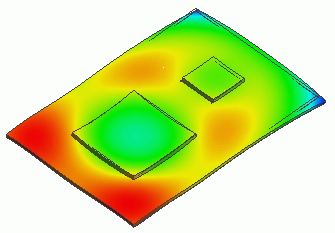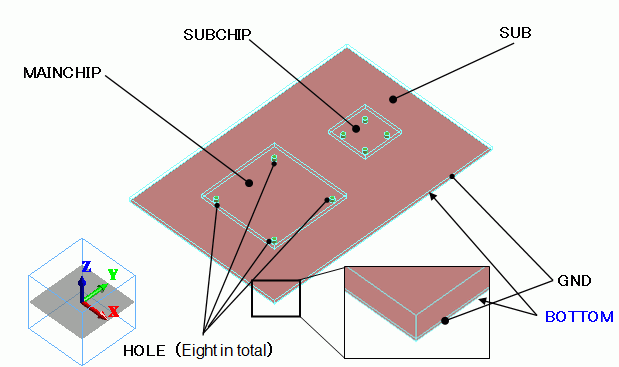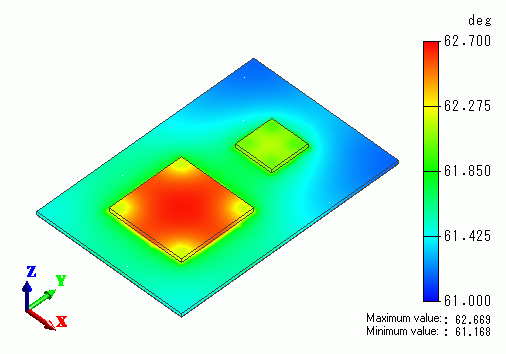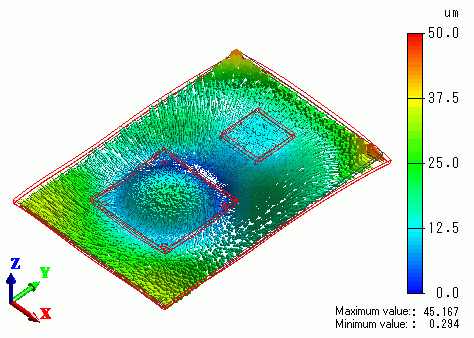
CAE Software【Femtet】Murata Software Co., Ltd.

Example3 Deformation due to the Temperature Gradient #3 – Multiple Materials

General
-
A heating chip is mounted on a substrate. The temperature gradient caused by the heating chip is calculated by thermal analysis [Watt]. This is the same as Exercise 10 of thermal analysis.
Then, the deformation due to the temperature gradient is solved by Galileo (mechanical stress analysis).
-
The temperature gradient caused by the heating chip is calculated by Watt
The result is forwarded to Galileo as a thermal load.
-
The deformation, the displacement and the mechanical stress are solved.
-
Unless specified in the list below, the default conditions will be applied.
Analysis Space
|
Item |
Settings |
|
Analysis Space |
3D |
|
Model unit |
mm |
Analysis Conditions
Select Thermal analysis and Mechanical stress analysis.
|
Item |
Settings |
|
Solvers |
Thermal analysis [Watt] |
|
Thermal-Analysis Type |
Steady-State Analysis |
|
Options |
N/A * |
* “Thermal Load” is selected by default for the thermal load-mechanical stress coupled analysis.
The Step/Thermal Load tab is set as follows.
|
Tab |
Setting Item |
Settings |
|
Step/Thermal Load * |
Reference temperature |
25[deg] |
* The reached temperatures come from the thermal analysis.
Model
The same as Exercise 10 of thermal analysis.

Body Attributes and Materials
|
Body Number/Type |
Body Attribute Name |
Material Name |
|
0/Solid |
SUB |
006_Glass_epoxy * |
|
1/Solid |
GND |
008_Cu * |
|
2/Solid |
MAINCHIP |
001_Alumina * |
|
3/Solid |
SUBCHIP |
001_Alumina * |
|
4/Solid |
HOLE |
008_Cu * |
|
5/Solid |
HOLE |
008_Cu * |
|
6/Solid |
HOLE |
008_Cu * |
|
7/Solid |
HOLE |
008_Cu * |
|
8/Solid |
HOLE |
008_Cu * |
|
9/Solid |
HOLE |
008_Cu * |
|
10/Solid |
HOLE |
008_Cu * |
|
11/Solid |
HOLE |
008_Cu * |
* Available from the Material DB
The heat sources of MAINCHIP and SUBCHIP are set up as follows.
|
Body Attribute Name |
Tab |
Settings |
|
MAINCHIP |
Heat Source |
0.2[W] |
|
SUBCHIP |
Heat Source |
0.1[W] |
Boundary Conditions
The heat transfer coefficient for the natural convection is set on the bottom face of GND as follows:
The radiation from the top and the sides is omitted.
|
Boundary Condition Name/Topology |
Tab |
Boundary Condition Type |
Settings |
|
Bottom/Face |
Thermal |
Heat Transfer/Ambient Radiation |
Natural convection*: 1.39[W/m2/deg5/4] Room Temperature : 25[deg] |
* The coefficient for the natural convection is calculated as follows. See [Heat Transfer/Ambient Radiation] for more information.
2.51×C×(1/L)^(1/4) = 1.39 [W/m2/deg5/4]
where
C = 0.26
Size of the substrate : 0.06×0.04
L (Typical Length) = (0.06 x 0.04 x 2) / (0.06 + 0.04) = 0.048
Results
The temperature distribution as a result of Watt is shown below.

The next figure shows the vectors of displacement as a result of Galileo following Watt.

The substrate corners which shows the low temperature are bent downward.

